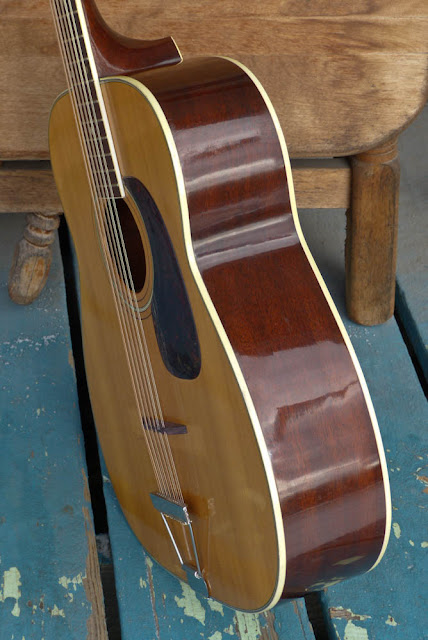1967 Harmony H1270 Jumbo 12 String Guitar
Looking for that big, punchy, brutal Leadbelly sound but don't have the multi-thousands for a true 20s Stella 12 string? Yeah, these will get you really close: with 25 1/4" scale lengths, a big 16" ladder-braced dread-depth body, and a 12-fret neck joint they're about the only more "modern" guitar that comes close to the old specs -- and it's still nearly 50 years old.
The caveat is that these play and sound like crud until they're given a neck reset, good setup, and a bridge that's not so crazy and poorly thought-out as the original floating ones. After that's done (as in this case), these will simply knock your socks off with volume, carrying power, thump, and easy action. Those that own tailpiece 12s know how much slinkier the feel is due to the extra string length -- and when the setup is dialed-in "on spec" (3/32" EA and 1/16" DGBE at the 12th fret) it's fairly effortless to play. Still -- the nut is a hefty 2" and the profile of the neck is a medium D shape -- it's not for everyone!
This guitar is in fantastic shape with no cracks and very little use-wear throughout. The biggest "flaw" is the shadow of the old floating bridge on the top.
The tuners are holding just fine and are freshly lubed. The headstock has a rosewood veneer, the truss works well and the neck is dead-straight. I have this strung up with 47w-10 standard "12 string lights" and detuned a step. I've tuned it up to open D, however, with no issue, and it will be fine for standard E-to-E as well. I just love that low rumble!
The nut is the original plastic one.
Note the "groovy" board. I've mentioned this before, but as Harmony guitars moved into later and later production these get more and more obvious. Late 40s guitars show it a little here and there and by the 60s it's evident they were just churning out radiused boards on the same, aging machine. Funny but true!
The dots are faux-pearl and the board is rosewood and bound with a 14" radius on the surface. The frets are all original and nearly full-height. I gave them just the lightest fret level/dress.
I had to reglue the pickguard which is sort of a chore as the original adhesive is mucky to remove and these nearly always warp so you have to clamp the heck out of them. It's now in good stead.
My new Gibson-ish 20s-style rosewood bridge is a lot lighter-weight and tone-savvy than the original. It also intonates very, very well up the neck as I've compensated for each string individually. This makes a huge difference to playing enjoyment if you're like me and like to tune 12s in an open tuning and capo all over the neck.
Original tail...
The back and sides are solid mahogany while the top is solid spruce.
The neck is also a big hunk of mahogany, too.
As you can see, I keep the strings out of the little holes at the front of the tailpiece and simply tuck them under the lower edge. This removes weird overtones and rattles which are an unintended "feature" of the "double hole" trapeze tails. Drives me crazy!
There's plenty of back-angle, by the way, for years of bridge-height reduction if need be. My new bridge is almost half-again (or more) taller than the original saddle height on these.



















Comments